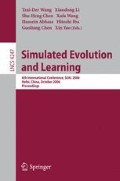Abstract
Evolutionary Learning Classifier Systems (LCSs) are rule based systems that have been used effectively in concept learning. XCS is a prominent LCS that uses genetic algorithms and reinforcement learning techniques. In traditional machine learning (ML), early stopping has been investigated extensively to the extent that it is now a default mechanism in many systems. However, there has been a belief that EC methods are more resilient to overfitting. Therefore, this topic is under-investigated in the evolutionary computation literature and has not been investigated in LCS. In this paper, we show that it is necessary to stop evolution in LCS using a stopping criteria other than a maximum number of generations and that evolution may suffer from overfitting similar to other ML methods.
Access this chapter
Tax calculation will be finalised at checkout
Purchases are for personal use only
Preview
Unable to display preview. Download preview PDF.
References
Bacardit, J., Butz, M.V.: Data Mining in Learning Classifier Systems: Comparing XCS with GAssist. Illinois Genetic Algorithms Laboratory, University of Illinois at Urbana-Champaign, IlliGAL Report No. 2004030 (June 2004)
Bernadó, E., Llorà, X., Garrell, J.M.: XCS and GALE: a comparative study of two learning classifier systems with six other learning algorithms on classification tasks. In: Lanzi, P.L., Stolzmann, W., Wilson, S.W. (eds.) IWLCS 2001. LNCS (LNAI), vol. 2321, pp. 337–341. Springer, Heidelberg (2002)
Elkan, C.: Results of the kdd 1999 classifier learning. SIGKDD Explor. Newsl. 1(2), 63–64 (2000)
Greenyer, A.: CoIL Challenge 2000. The use of a learning classifier system JXCS. Technical Report LIACS Technical Report 2000-09, Sentient Machine Research, Amsterdam and Leiden Institute of Advanced Computer Science, Leiden (June 22, 2000)
Hettich, S., Bay, S.D.: The UCI KDD Archive (1999), http://kdd.ics.uci.edu/databases/kddcup99/kddcup99.html
N. S. Inc. Online available at http://www.nutechsolutions.com/ (2003)
Kovacs, T., Kerber, M.: High classification accuracy does not imply effective genetic search. In: Deb, K., et al. (eds.) GECCO 2004. LNCS, vol. 3102, Springer, Heidelberg (2004)
Wilson, S.W.: Get Real! XCS with Continuous-Valued Inputs. In: Lanzi, P.L., Stolzmann, W., Wilson, S.W. (eds.) IWLCS 1999. LNCS (LNAI), vol. 1813, pp. 209–219. Springer, Heidelberg (2000)
Shafi, K., Abbass, H., Zhu, W.: The role of early stopping and population size in XCS for intrusion detection. Technical Report TR-ALAR-200604006, Defence and Security Applications Research Centre, University of New South Wales ADFA, Canberra, Australia (2006)
Wilson, S.W.: Classifier fitness based on accuracy. Evolutionary Computation 3(2), 149–175 (1995)
Author information
Authors and Affiliations
Editor information
Editors and Affiliations
Rights and permissions
Copyright information
© 2006 Springer-Verlag Berlin Heidelberg
About this paper
Cite this paper
Shafi, K., Abbass, H.A., Zhu, W. (2006). The Role of Early Stopping and Population Size in XCS for Intrusion Detection. In: Wang, TD., et al. Simulated Evolution and Learning. SEAL 2006. Lecture Notes in Computer Science, vol 4247. Springer, Berlin, Heidelberg. https://doi.org/10.1007/11903697_7
Download citation
DOI: https://doi.org/10.1007/11903697_7
Publisher Name: Springer, Berlin, Heidelberg
Print ISBN: 978-3-540-47331-2
Online ISBN: 978-3-540-47332-9
eBook Packages: Computer ScienceComputer Science (R0)

